#Medicine in China
Text
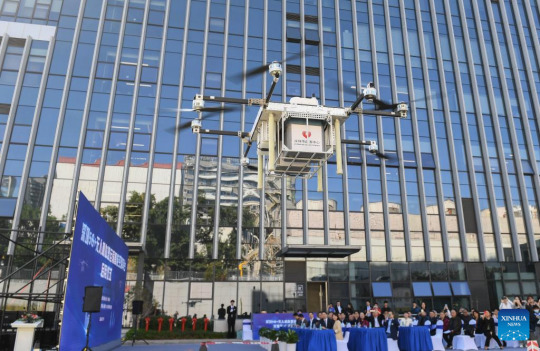




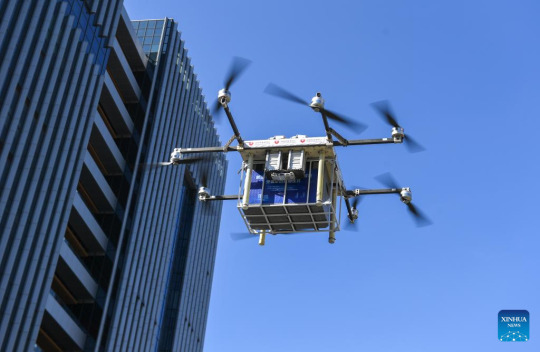
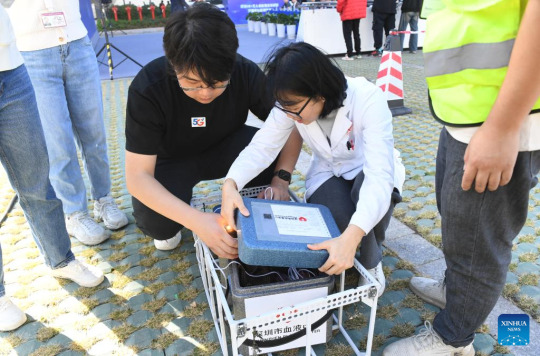
🇨🇳 🏨 🚨 CHINA IMPLEMENTS DRONE PROGRAM FOR BLOOD TRANSPORTATION IN SHENZHEN PROVINCE
📸 Photos from the implementation of a new drone transportation platform for blood transfusion emergencies at the Shenzhen Blood Center in Shenzhen, in the southern Chinese province of Guangdong.
The new program was implemented by the Shenzhen Blood Center and is seen here being used for the transportation of blood from the Shenzhen Traditional Chinese Medicine Hospital for the first time on Friday, January 19th, 2024.
Integrating both Artificial Intelligence (AI) and 5G communications technology, the new platform is said to help "ensure safety and improved efficiency of blood transportation," according to an article published in China's Xinhua News Agency.
#source
@WorkerSolidarityNews
#china#china news#chinese news#blood transportation#blood transfusion#medical news#technology#tech news#news in china#politics#news#geopolitics#world news#global news#international news#breaking news#current events#medical technology#medicine in china#chinese politics
4 notes
·
View notes
Text


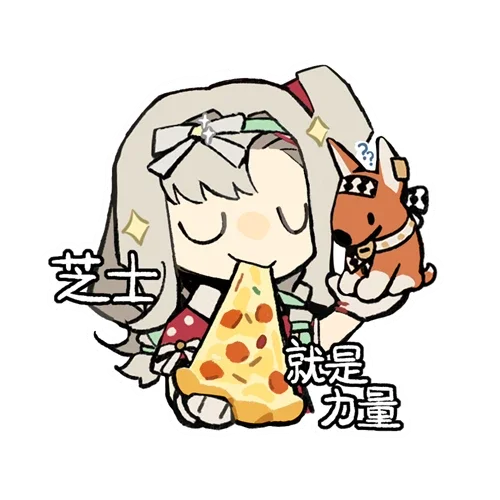
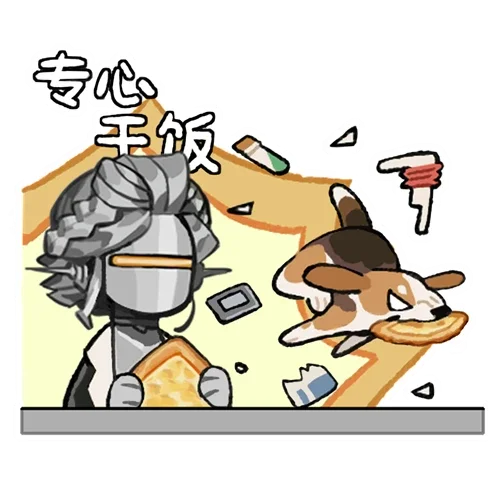

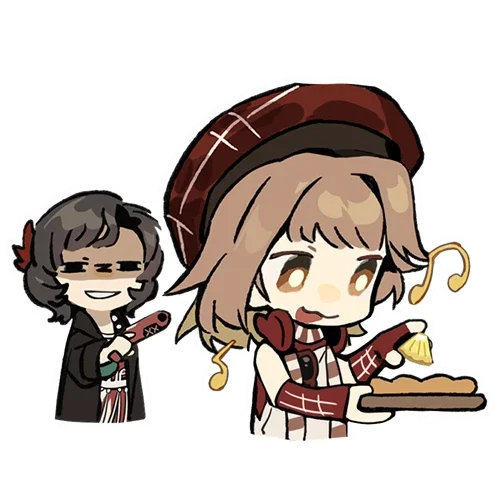
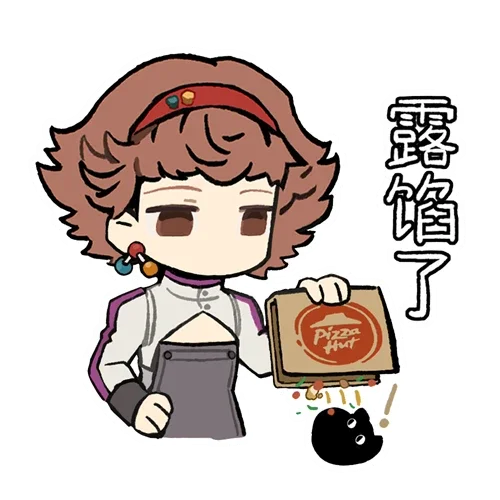
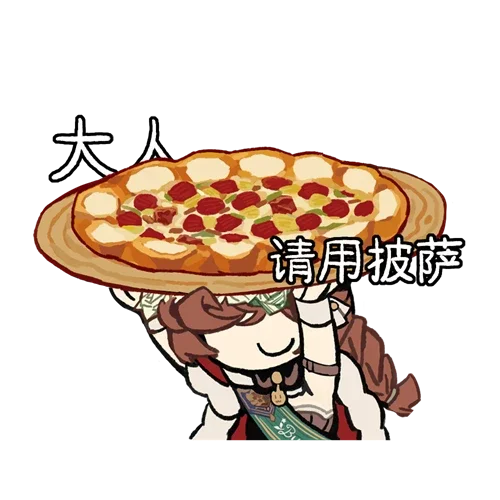
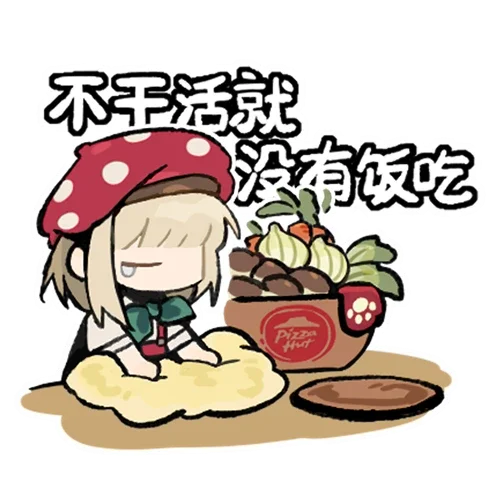
Emotes from the Pizza Hut x Reverse: 1999 Crossover now available on WeChat. Also available as stickers at the in-person event.
#medicine pocket#bilibili#china#emotes#reverse: 1999#reverse 1999#r1999#matilda#ezra#mesmer jr#lucy#schneider#toothfairy#jessica#regulus
264 notes
·
View notes
Text
"In a significant medical milestone, Chinese scientists have successfully cured a patient's diabetes using a groundbreaking cell therapy. This pioneering treatment was developed by a team from Shanghai Changzheng Hospital, the Centre for Excellence in Molecular Cell Science under the Chinese Academy of Sciences, and Renji Hospital, and was detailed in the journal Cell Discovery on April 30."
"The new therapy involves programming the patient's peripheral blood mononuclear cells, transforming them into "seed cells" to recreate pancreatic islet tissue in an artificial environment. This approach leverages the body's regenerative capabilities, an emerging field known as regenerative medicine."
"Our technology has matured and it has pushed boundaries in the field of regenerative medicine for the treatment of diabetes," Yin stated."
This is GROUNDBREAKING and incredible recent news. I've been seeing some US news sources cry 'but what about capitalism,' and it's disgusting. The US among any country without universal and accessible healthcare see cures and prevention as threats. There's WAY more business in sick people and keeping people sick, right US Government? Deplorable.
#china#science#breaking news#global news#world news#diabetes#diabetes research#research#medical study#public health#united states#fuck capitalism#abolish capitalism#anti capitalism#medicine#healthcare#news
67 notes
·
View notes
Text
Good News - August 8-14
Like these weekly* compilations? Tip me at $kaybarr1735 or check out my new(ly repurposed) Patreon! (*sorry this one’s a day late, I had a family emergency)
1. Rio’s grassroots agroforestry sustains birds, bees & communities

“[Community-created and -maintained] agroforests have reshaped the urban landscape and now attract an array of fauna, from birds to bees and even fireflies, drawn by the diversity of plant life thriving on improved soils. Perhaps most importantly, the agroforests offer free food and medicines to residents in need, plus shade and educational opportunities for the whole community[….]”
2. First giant pandas from China in decades make their public debut in San Diego

(image source) “Tensions between the U.S. and China had temporarily paused the program known as "panda diplomacy" in which China loans its native animals to zoos around the world […] as a show of goodwill[….] But the presence of [the two pandas in San Diego] appears to show a mending of the diplomatic relationship, which Chinese President Xi Jinping pledged to work toward in a meeting with President Biden last year. [… Gov. Newsom] called the giant pandas an example of how strong worldly partnerships can protect wildlife and their habitats[….]”
3. Good news for Europe's top economies as disposable income rises

“Poland experienced the largest increase in disposable income per capita, rising by 10.2% compared with a decrease of 2.7% in the last quarter of 2023. According to the OECD, this growth was "mainly driven by increases in employee compensation, social benefits other than in-kind transfers, and property income". […] In Germany, [household income per capita] rose by 1.4%, compared to just 0.1% in the previous quarter, partly driven by an increase in employee compensation.”
4. FDA approves nasal spray as first needle-free treatment for anaphylaxis
“The spray, which will be sold under the brand name Neffy, is seen as an alternative to EpiPen and other autoinjectors. […] “Some people, particularly children, may delay or avoid treatment due to fear of injections,” said Kelly Stone, an associate director at the FDA’s Center for Drug Evaluation and Research, adding that the availability of the nasal spray may reduce barriers to rapid treatment.”
5. [Colin Farrell] is launching a foundation to support adult[s] who have an intellectual disability

““We want to take a good look at residential potential for families with young adults who are ready to go out into the world and have a greater sense of community and connection,” says the actor. […] "It’s really important for James and for all of our kids to feel like they are wanted, to feel like they’re part of the community. Not just out of charitable endeavors or being nice and doing the right thing, but out of a sincere desire to engage and learn about each other."”
6. The Berlin Zoo is hoping for more German-born giant pandas as scans confirm a pregnancy

“Giant pandas have difficulty breeding and births are particularly welcomed. There are about 1,800 pandas living in the wild in China and a few hundred in captivity worldwide. […] The zoo noted that female pandas are only capable of reproducing for about 72 hours per year.”
7. Arizona school district highlights the benefits of free lunch
“A study by the University of Washington found free meals at school help reduce hunger, reduce the stigma tied to free lunch, and can help reduce childhood obesity. [… A cafeteria worker] said since the school district began offering free lunch, they have seen a positive shift in the cafeteria culture, and students seem happier. […] In September of 2023, the USDA […] loosened up its application threshold for applicants, allowing an estimated 3,000 more school districts in high-need areas to participate in the [CEP] program.”
8. Gigantic millipede lost to science for 126 years rediscovered in remote Madagascan jungle

“A further 20 species 'lost' to science were rediscovered during the expedition, including three iridescent species of fish and several species of ant-like flower beetles.”
9. The climate law’s $8.8B in home energy rebates are starting to roll out

“New York and Wisconsin are the first to launch their long-awaited Inflation Reduction Act programs meant to deploy everything from heat pumps to insulation. […] Once deployed, the DOE estimates, the home energy rebates will help save consumers up to $1 billion in annual energy costs and support an estimated 50,000 U.S. jobs in construction, manufacturing, and other sectors. They’ll also help clean up buildings, one of the biggest sources of carbon pollution in the country.”
10. Advance in stem cell therapy: New technique for manipulating stem cells opens door to novel treatments

“Recently, a team of McGill researchers discovered that by stretching, bending and flattening the nuclei of stem cells to differing degrees, they could generate precisely targeted cells that they could direct to become either bone or fat cells. […] The first applications of this discovery are likely to involve bone regeneration, possibly relating to dental or cranio-facial repair[….]”
August 1-7 news here | (all credit for images and written material can be found at the source linked; I don’t claim credit for anything but curating.)
#hopepunk#good news#community#agroforestry#community garden#panda#china#giant panda#disposable income#economy#living wage#fda#epipen#allergies#medicine#actor#intellectual disability#disability#germany#free lunch#free food#school#insect#bug#tw insects#tw bugs#millipede#climate change#science#stem cell therapy
31 notes
·
View notes
Text

#instagram#instagram post#instagram stuff#social justice#current events#human rights#important#china#usa#united states#cancer#medical#medical treatment#medical technology#tech news#tech#technews#diabetes#diabetic#diabetes treatment#diabetes tag#diabetic care#political#political posting#politics#world politics#chinese politics#united states politics#american politics#medicine
26 notes
·
View notes
Text

Guys please, the intrusive thoughts are winning. If anything is gonna stop me it’s my fear of flying not the fact this is an extremely manic decision.
51 notes
·
View notes
Text
Doctor Elise Qi Rong AU
in which shortly after dying in canon (i know that since his ashes weren’t destroyed that he’s probably still alive but please bear with me), qi rong finds himself reincarnated in the modern world and decides that in this life he's going to become someone that guzi would proudly call his father (nevermind the fact that the kid loves him just the way he is), and decides that in order for that to happen, he’s going to become a doctor and save lives and he ends up becoming a super accomplished surgeon with an extremely high success rate.
unfortunately while on his way home from a hospital shift, he ends up getting hit by a truck (you know i had to include truck-kun in this au!) and when he wakes up, he’s in his bedroom back when he was still prince xiao jing of xianle.
the good news is that he can be reunited with guzi again, the bad news is that he’s going to have to wait 800 years before the reunion can happen.
so because he can't really do anything but wait, qi rong decides that he's going to continue his work as a doctor and he ends up accidentally single-handedly revolutionizing ancient china's world of medicine along the way.
#tian guan ci fu#tgcf#heaven official's blessing#hob#qi rong#xiao jing#prince xiao jing#qi rong au#tgcf au#dr elise qi rong au#qi rong decides to revolutionize the world of medicine of ancient china while he waits to be reunited with his beloved son#and that is how qi rong accidentally ends up ascending as a god of medicine (he's not mad about it but he didn't expect that to happen)#the entire palace is highly suspicious of qi rong because yeah they're glad that he's actually behaving but why is he behaving now?#qi rong suddenly acts like a well-behaved kid and alarm bells are ringing in the royal family's head because what tf happened?#qi rong's also dealing with the fact that he's going to have to wait 800 years to see guzi again and he's pretty sad about it#the current theory is that someone is possessing qi rong but that ended up being disproved by mei nianqing#qi rong is experiencing child loss but his child hasn't even been born yet which makes it even worse#qi rong lived in the modern world and now that he's back in ancient china again there's so much things that he's now appalled by#also it'd be funny if he just spoke only using modern slang only for everyone else to be like 'wtaf is this boy talking about?'#tian guan ci fu au#qi rong being a good dad somehow turns him into a better person (he wants the best for his son and if changing will do that then he will)#doctor qi rong#the palace see qi rong with his medical tools and are terrified because to them (people from ancient times) they look like torture tools#qi rong accidentally becomes a heavenly official and he hates it so much (but he's also super smug about too (at least he doesn't die now))#qi rong misses the modern world a little bit because at least the clothes didn't have multiple layers (he misses his sweatpants so much)#qi rong tgcf#qi rong has a degree and he's going to use it to better the world (this is all part of his plan for guzi to be proud to call him dad)#this was also inspired by another manhwa called 'the divine surgeon'#qi rong is chanting don't be suspicious in his head while being the most suspicious person alive to the rest of his family#qi rong accidentally redeems himself because he wants to be the best for his son
35 notes
·
View notes
Text
“Yin-Yang theory is based on the philosophical construct of two polar complements, called Yin and Yang. These complementary opposites are neither forces nor material entities. Nor are they mythical concepts that transcend rationality. Rather, they are convenient labels used to describe how things function in relation to each other and to the universe. They are used to explain the continuous process of natural change. But Yin and Yang are not only a set of correspondences; they also represent a way of thinking. In this system of thought, all things are seen as parts of a whole. No entity can ever be isolated from its relationship to other entities; no thing can exist in and of itself. Fixed essences are abstractions; there are no absolutes. Yin and Yang must, necessarily, contain within themselves the possibility of opposition and change.”
Ted Kaptchuk. “The Web That Has No Weaver.”
13 notes
·
View notes
Text
Nothing in the past, moreover, gave any cause to suspect ginseng’s presence so far away. Or even closer by: since antiquity, for well over a millennium, the ginseng consumed in all of East Asia had come from just one area -- the northeast mountainous lands straddling Manchuria and Korea. No one had found it anywhere else. No one was even thinking, now, to look elsewhere. The [...] [French traveler] Joseph-Francois Lafitau didn’t know this. He had been [...] visiting Quebec on mission business in October of 1715 [...]. He began to search for ginseng. [...] [T]hen one day he spotted it [...]. Ginseng did indeed grow in North America. [...]
Prior to the nuclear disaster in the spring of 2011, few outside Japan could have placed Fukushima on a map of the world. In the geography of ginseng, however, it had long been a significant site. The Edo period domain of Aizu, which was located here, had been the first to try to grow the plant on Japanese soil, and over the course of the following centuries, Fukushima, together with Nagano prefecture, has accounted for the overwhelming majority of ginseng production in the country.
Aizu’s pioneering trials in cultivation began in 1716 – by coincidence, exactly the same year that Lafitau found the plant growing wild in the forests of Canada. [...]
---
Since the 1670s the numbers of people [in Japan] clamoring for access to the drug had swelled enormously, and this demand had to be met entirely through imports. The attempt to cultivate ginseng in Aizu -- and soon after, many other domains -- was a response to a fiscal crisis.
Massive sums of silver were flowing out of the country to pay for ginseng and other drugs [...]. Arai Hakuseki, the chief policy maker [...], calculated that no less than 75% of the country’s gold, and 25% of its silver had drained out of Japan [to pay for imports] [...]. Expenditures for ginseng were particularly egregious [...]: in the half-century between 1670s through the mid-1720s that marked the height of ginseng fever in Japan, officially recorded yearly imports of Korean ginseng through Tsushima sometimes reached as much as four to five thousand kin (approx. 2.4–3 metric tons).
What was to be done? [...] The drain of bullion was unrelenting. [...] [T]he shogunate repeatedly debased its currency, minting coins that bore the same denomination, but contained progressively less silver. Whereas the large silver coin first issued in 1601 had been 80% pure, the version issued in 1695 was only 64% silver, and the 1703 mint just 50%. Naturally enough, ginseng dealers in Korea were indifferent to the quandaries of the Japanese rulers, and insisted on payment as before; they refused the debased coins. The Japanese response speaks volumes about the unique claims of the drug among national priorities: in 1710 (and again in 1736) a special silver coin of the original 80% purity was minted exclusively for use in the ginseng trade. [...]
[T]he project of cultivating ginseng and other medicines in Japan became central to the economic and social strategy of the eighth shogun Yoshimune after he assumed power in 1716. [...]
---
China and Korea were naturally eager to retain their monopolies of this precious commodity, and strictly banned all export of live plants and seeds. They jealously guarded as well against theft of mature roots: contemporary Chinese histories, for example, record that the prisons of Shenjing (present day Shenyang) overflowed with ginseng poaching suspects. So many were caught, indeed, that the legal bureaucracy couldn’t keep up.
In 1724, the alarming numbers of suspected poachers who died in prison while awaiting trial led to the abandonment of the regular system of trials by judges dispatched from Beijing, and a shift to more expeditious reviews handled by local officials. [...]
Even in 1721. the secret orders that the shogunate sent the domain of Tsushima called for procuring merely three live plants [...]. Two other forays into Korea 1727 succeeded in presenting the shogun with another four and seven plants respectively. Meanwhile, in 1725 a Manchu merchant in Nagasaki named Yu Meiji [...] managed to smuggle in and present three live plants and a hundred seeds. [...]
Despite its modest volume, this botanical piracy eventually did the trick. By 1738, transplanted plants yielded enough seeds that the shogunate could share them with enterprising domains. [...] Ginseng eventually became so plentiful that in 1790 the government announced the complete liberalization of cultivation and sales: anyone was now free to grow or sell it.
---
By the late eighteenth century, then, the geography of ginseng looked dramatically different from a century earlier.
This precious root, which had long been restricted to a small corner of the northeast Asian continent, had not only been found growing naturally and in abundance in distant North America, but had also been successfully transplanted and was now flourishing in the neighboring island of Japan. […]
---
Colonial Americans, for their part, had developed their own new addiction: an unquenchable thirst for tea. […] This implacable need could have posed a serious problem. [...] [I]ts regular consumption was a costly habit.
Which is why the local discovery of ginseng was a true godsend.
When the Empress of China sailed to Canton in 1784 as the first ship to trade under the flag of the newly independent United States, it was this coveted root that furnished the overwhelming bulk of sales. Though other goods formed part of early Sino-American commerce – Chinese porcelain and silk, for example, and American pelts – the essential core of trade was the exchange of American ginseng for Chinese tea. [...]
---
Yoshimune’s transplantation project had succeeded to the point that Japan actually became a ginseng exporter. As early as 1765, Zhao Xuemin’s Supplement to the compedium of material medica would note the recent popularity of Japanese ginseng in China. Unlike the “French” ginseng from Canada, which cooled the body, Zhao explained, the “Asian” ginseng (dongyang shen) from Japan, like the native [Korean/Chinese] variety, tended to warm. Local habitats still mattered in the reconfigured geography of ginseng. [...]
What is place? What is time? The history of ginseng in the long eighteenth century is the story of an ever-shifting alchemical web. [...] Thanks to the English craving for tea, ginseng, which two centuries earlier had threatened to bankrupt Japan, now figured to become a major source of national wealth [for Japan] .
---
Text by: Shigehisa Kuriyama. “The Geography of Ginseng and the Strange Alchemy of Needs.” In: The Botany of Empire in the Long Eighteenth Century, edited by Yota Batsaki, Sarah Burke Cahalan, and Anatole Tchikine. 2017. [Bold emphasis and some paragraph breaks/contractions added by me.]
#all kinds of fun stuff smuggling piracy biogeography medicinal tea shogunates secret orders#the irony of emerging US empire beginning relationship with china based on export of american ginseng which europeans hadnt known existed#the irony of japan quickly transitioning from almost being bankrupted by ginseng to becoming a ginseng exporter#the importance of local habitats and smallscale biogeography despite the global scale of imperial trade#the french cartographer in 1711 in manchuria who had never been to canada but correctly predicted ginseng might grow there#abolition#ecology#imperial#colonial
106 notes
·
View notes
Text









outlined in black and white.. ♡
Tsukimiya Rucia MAD MEDiCiNE
Ice/Aisu iLiFE!
Yuno Woyuta NANIMONO
CHINA Cinderella Sengen!
Hanayama Akari LinQ
Yurizono Emma metarium
Fujimiya Mei Appare!
Takanashi Rui BABABABAMBI

#moodboard#black and white#tsukimiya rucia#mad medicine#madmed#ice#aisu#ilife#ilife!#yuno woyuta#nanimono#china#cinderella sengen!#cinderella sengen#hanayama akari#linq#yurizono emma#metarium#fukumiya mei#appare#appare!#takanashi rui#babababambi#jpop girl group#jpop idol#jpop
16 notes
·
View notes
Text





#chinese medicine#traditional chinese medicine#chinese#china#dried plants#jars#dried herbs#the glass bulbs in the second to last pic are for a specific practice#and i want to tag it but given tumblr's ridiculousness i'm afraid the post will get flagged XD#let's try saying like c4pp1ng?#do you think i can say that?#idk man i guess we'll see#op
3 notes
·
View notes
Text
Pizza Hut Collab Cosers









Attached Text (Bilibili)
窝最近收集到了很多……很多……关于必胜派对的影像,连银色大箱子里的盆友们也举办��了必胜派对!
也���……窝也应该邀请窝的盆友们一起找个票……亮<漂……亮>的箱子进行一场属于窝们的必胜派对,留下一些珍贵的影像!
Bilibili Link:
嘭嘭放映机1999的动态 - 哔哩哔哩 (bilibili.com)
#medicine pocket#lucy#ezra#engima#x#regulus#bilibili#china#cosplay#pizza hut#collab#reverse: 1999#reverse 1999#r1999#other sites have different text#but theyre mostly the same#laplace pizza party
55 notes
·
View notes
Text
Taoist Bigu Practice: Is It About Health Preservation?
A few thoughts on a millennia old austerity practice, bigu (辟穀) fasting, “abstention from cereals”.
Nowadays, this concept is hyped and heavily misinterpreted: some argue that it implies extreme starvation, some claim that this is a special diet associated with the restriction of starchy foods and aimed at losing weight.
It’s an old-school practice, also called Duangu (Stop Cereals, 斷谷), Juegu…

View On WordPress
#ancient China#bigu#Chinese culture#golden elixir#healing practices#neidan#qigong#Tang dynasty#Taoism#Taoist alchemy#Taoist healing#Taoist practices#traditional Chinese medicine
16 notes
·
View notes
Text
instagram

#instagram#instagram post#instagram stuff#social justice#current events#human rights#diabetes#insulin#important#important to know#political#political posting#politics#us politics#united states politics#usa politics#american politics#genocide joe#butcher biden#joe biden#traitor trump#donald trump#china#chinese politics#medical#medical post#medical problems#medical technology#tech news#medicine
6 notes
·
View notes
Text
Let's Eat Medicine Pocket!

They released the themed dishes for Med Poc, let's goooo! Let's drink an orange sedative to wash down whatever the hell we just ate!
#medicine pocket#reverse: 1999#reverse 1999#r1999#china#ipstar#food#ima be for real tho aside from the dessert and drink med pocs food looks the least appealing out of everyones but its cheap so who cares?
33 notes
·
View notes
Link
A large trial investigating the effectiveness of a celery-seed-derived neuroprotectant drug for use in ischemic stroke cases has shown significant promise.
Patients given the medicine called butylphthalide had a 70% better chance of improved neurological and general living outcomes 90 days post-stroke, a finding generated from a little over 1,000 cases.
Butylphthalide is already approved for use in treating strokes in China. Currently though, the FDA has not approved it for any use.
How butylphthalide works isn’t clear, with animal studies suggesting various possible mechanisms. It may help protect brain tissue from damage when the supply of oxygenated blood is cut off and it works alongside existing clot-busting drugs or procedures to remove blood clots in ischemic stroke conditions.
The trial consisted of 1,216 patients who were admitted for stroke in China where the drug is approved for use, and given it alongside a tissue plasminogen activator (tPA) and/or a mechanical clot removal procedure—two primary means of dealing with ischemic, or clot strokes.
Every year, more than 795,000 people in the United States have a stroke, with 87% of these being ischemic ones. The burden of these events is large, and they are a leading cause of disability in the elderly.
“This is the first trial to show the benefit of using a medication that protects the brain from damage caused by a lack of oxygen to brain tissue...” said Baixue Jia, M.D., co-author of the study...
The results will soon be presented to the International Stroke Conference this week in Dallas, Texas.”
-via Good News Netwwork, 2/6/23
#stroke#medicine#medical research#medical news#ischemic stroke#china#brain#neuroscience#aging#good news#hope
40 notes
·
View notes